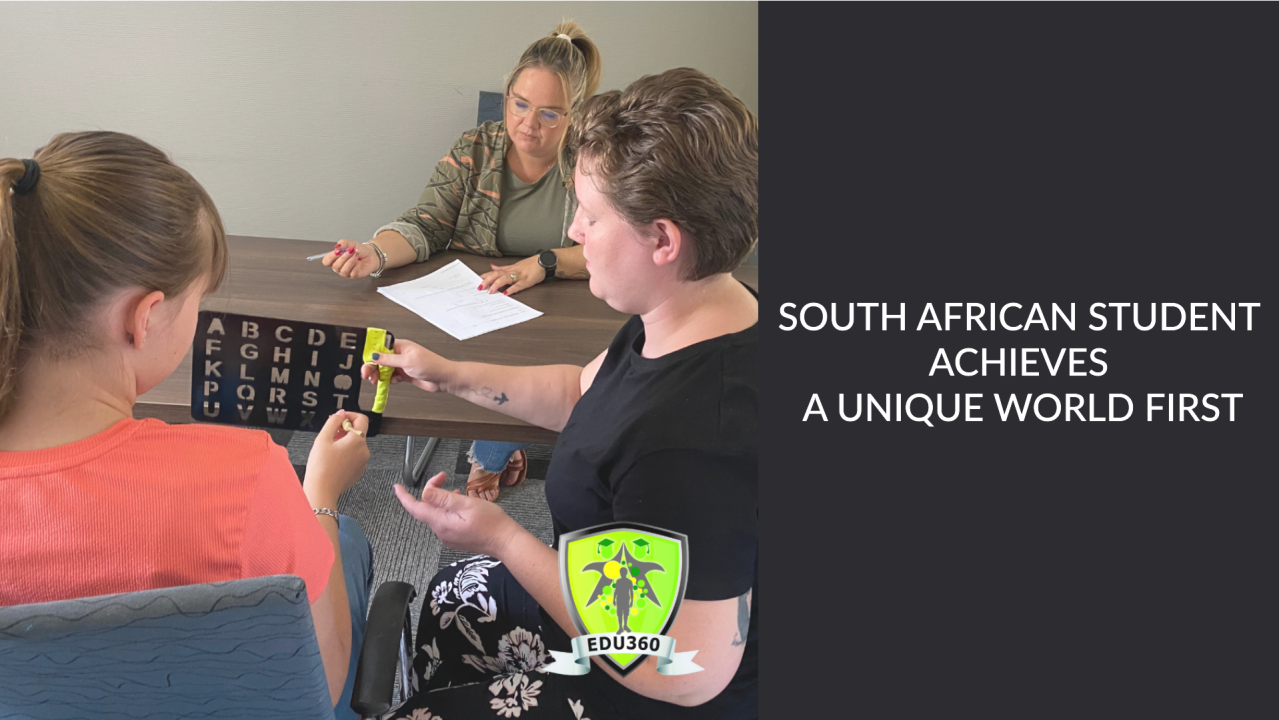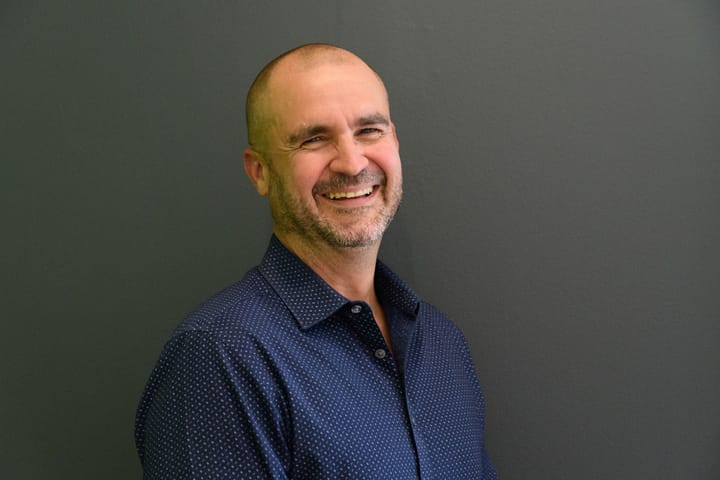South African Student Achieves a Unique World First

Johannesburg, South Africa – While the country was awash with news of high school pass rates and matric student achievements, nineteen-year-old Stephanie Pringle, a non-speaking Autistic student using a letterboard to communicate, celebrated writing and passing her Cambridge Examinations in Extended Mathematics and Business Studies.
Stephanie is the first non-speaking Autistic student in the world to use a letterboard to complete (and pass) her Cambridge examinations.
Stephanie has apraxia – a disorder of the brain and nervous system in which she is unable to perform tasks when asked, even though she understands the request and is willing to do the task. This inability to perform simple movements makes her unable to speak or write reliably. A letterboard empowers non-speakers like Stephanie to overcome communication barriers posed by traditional oral and written communication by pointing to letters on a board to express thoughts. With ongoing practice, it promotes synchrony between cognitive and motor systems. A facilitator trained in using this tool works with the students to regulate their bodies and relay their spelled-out thoughts or answers.
Stephanie’s success is due to her dedication and determination to do well, her trained facilitator, and her work behind the scenes to ensure she is granted the necessary concessions to write her examinations.
Jacqui McKelvey, the principal (and co-founder) of Stephanie’s specialist school, EDU360, engaged the Cambridge system through the British Council Office when she registered to write.
“This was the beginning of the process. We began consultations with their team to grant the concessions Steph requires, which include a Regulation and Communication Partner, a Scribe and Reader, a separate venue, additional time, and an individual invigilator to monitor the process.
“The Council was receptive to the requirements, and together we worked hard to ensure Steph had what she needed in place to do her very best, right down to the day when she arrived, ready to begin her exams”, explains McKelvey.
Using a letterboard and trained facilitator is one of many tools in the Augmentative and Alternative Communication (AAC) quiver. ‘AAC’ is, quite simply, how someone communicates besides talking. ‘Augmentative’ means adding to one’s speech, while ‘alternative’ refers to tools used instead of speech. Some people may use AAC throughout their lives, while some may use it for periods when they can’t talk following an injury, illness or surgery, for example. AAC includes gestures and facial expressions, writing, drawing, and spelling words by pointing to letters on a letterboard or to photos, pictures, or written words. Technology can also assist with using an app or speech-generating devices.
Stephanie was diagnosed with a developmental delay just before she turned two. She received speech and occupational therapies and was diagnosed with Autism when she was four. Her schooling was limited to special needs education, where, according to her mum, Zelda, she failed to thrive.
“Steph was effectively in a holding pattern, with no reliable means of communication, doing Grades 1 and 2 work repeatedly for about eight years,” explains Zelda.
Stephanie had frequent tantrums and was quickly and often upset. Zelda and her husband searched for alternatives.
“One of our biggest frustrations,” says Zelda, “was that the first time we showed her something, she was excited, but by the second time, she’d lost interest. By the third time, she would start to resist entirely. This made weekly therapy sessions very difficult. We didn’t know then, but we understand now that she learns so fast and gets so excited by new material that she wants to continue learning. We kept holding her back because she couldn’t say the words or write the answers to prove her understanding. Imagine her frustration!”
Zelda said that they didn’t understand the behaviour at the time. During a formal assessment with an Occupational Therapist when Stephanie was about five, she failed all the easy tasks but passed the most challenging level.
“Once she could express herself using the letterboard, she communicated how irritated she became when she had to do the same task repeatedly. Her apraxia made it impossible to repeat tasks successfully, explaining the odd ‘successes’ and many ‘failures’,” says Zelda.
By the time Stephanie was a young teenager, her mental health and behaviour were “off the charts” and hugely problematic, as life at home was almost untenable.
It was then that Zelda came across the letterboard communication method. Something one of the mums using this method said resonated with her. “She said, ‘I am not telling you to stop the other things you are doing, but you simply HAVE to do this.’”
Zelda said this was the starting point for unlocking her daughter’s true potential. The letterboard provided Stephanie with a tool to communicate. The problematic behaviour, anger, and tantrums stopped almost completely.
The shift started in 2019 when Stephanie began learning how to spell on a letterboard with a trained practitioner. Initially, Zelda explained that it worked like a comprehension test, with simple questions and answers.
Through lockdown, Zelda kept practising with Stephanie and began working with her on ‘open communication’; she spells out her answer when you ask a question that has no known answer.
“In Maths,” Zelda recalls, “she progressed rapidly and easily from Grade 2 to Grade 7 work.”
Suddenly, Stephanie could access age-appropriate content and lessons, and everything changed.
Stephanie communicated that she taught herself how to read at four. Interestingly, many other ‘spellers’ (non-speaking individuals now communicating through a letterboard) have reported the same.
She communicated that life did not make sense to her and only started making sense once she could share her thoughts on the letterboard.
When schools opened again after lockdown, Stephanie communicated that she couldn’t go back to her original school, as she had outgrown the curriculum completely.
“We were in a real conundrum because she had never passed a Grade in her life, so what do we do? I was doing Grade 7 and 8-level work with her at home,” says Zelda.
When asked what grade Steph wanted to go into, she said matric! But now I had to find a school that would be willing to work with her.”
Zelda had heard about a special educational needs school which offered various pathways, including an academic programme, and employed an autistic teacher, Emile Gouws (now Dr Emile Gouws).
“I thought to myself, if any school was going to accept her, it might be one this forward-thinking and dynamic.”
Zelda and Stephanie met with the EDU360 team and were invited to come on ‘discovery’ to determine if it was a good fit.
“Stephanie’s first lesson was History with Mr Gouws. He introduced himself and asked her what she enjoyed. She answered ‘Harry Potter’ on her letterboard, and that was it!”
Stephanie was placed in Grade 9 in 2021 and loved every moment. She connected with teachers and soon her peers and excelled quickly.
Today, Stephanie communicates that although she believes she has an unlimited capacity for learning, feeding it back is the limiting factor. Despite the letterboard providing Stephanie with greater autonomy, she explains that the motor planning and eye tracking required slows her thinking down, so it only provides a fraction of what she fully understands and wants to communicate.
Stephanie is starting to learn how to work with a keyboard, but this, too, is an arduous process as it requires considerably more fine motor-planning. Practice is key. Her short-term goal is to achieve open communication on a keyboard by the time she goes to university.
Her dream, however, is to communicate telepathically. Technology already being tested uses electrodes and AI to track activation in the brain to accurately communicate what the person is thinking. Certainly, in Stephanie’s lifetime, this technology could be realised.
Steph and her family are passionate about communicating their success in hopes others can experience the same.
“It’s so important to understand that just because someone can’t verbalise, doesn’t mean they don’t understand or have something valuable to say,” says Stephanie.
Zelda adds: “We are so grateful for the times we are living in, being able to communicate with others across the world and learn from each other and share.”



